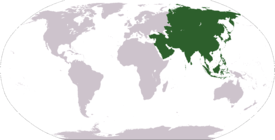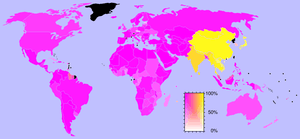Eastern world
| Part of a series on |
| Eastern culture |
|---|
|

The term Eastern world refers very broadly to the various cultures or social structures and philosophical systems of Asia or geographically the Eastern cultures. This includes the Far East (comprising Hong Kong, Japan, Macau, Mainland China, Mongolia, North Korea, South Korea, and Taiwan in East Asia, plus Brunei, Cambodia, East Timor, Indonesia, Laos, Malaysia, Myanmar, the Philippines, Singapore, Thailand, and Vietnam in Southeast Asia), the Asian part of the Greater Middle East (comprising Armenia, Azerbaijan, Bahrain, Cyprus, Georgia, Iran, Iraq, Israel, Jordan, Kuwait, Lebanon, Oman, Palestine, Qatar, Saudi Arabia, Syria, Turkey, the United Arab Emirates, and Yemen in Western Asia or the Middle East (aka the Near East), plus Kazakhstan, Kyrgyzstan, Tajikistan, Turkmenistan, and Uzbekistan in Central Asia), North Asia (aka Siberia), and South Asia (mainly the countries on the Indian subcontinent, comprising Afghanistan, Bangladesh, Bhutan, India, Nepal, and Pakistan, plus the British Indian Ocean Territory and the island countries of Sri Lanka and the Maldives in the Indian Ocean).
Due to the Mediterranean, or parts of it in both north and south, have formed in Classic times a single cultural and civilizational bloc, and due to the early expansion of the Islamic religion and the Arab language to all of its southern shores, North Africa (Algeria, Egypt, Libya, Morocco, Tunisia, Western Sahara, sometimes Mauritania and Sudan), the African part of the Greater Middle East, is often regarded as part of the Eastern world, while geographical Asian nations with a significant historical (pre-modern) or formative imprint of European populations and traditions such as the Philippines, or of those ultimately non-European in culture and origin whose indigenous populations were forced into Europe and its surrounding areas for a long period of time such as Israel, and in less mainstream views of what constitutes the Western world, Armenia, Azerbaijan, East Timor, Georgia, Hong Kong, Japan, Lebanon, Kazakhstan, Macau, Singapore, South Korea, Taiwan, and Turkey may be considered as Western at least in part, including being both Western and Eastern, while Cyprus even became part of the European Union in 2004 under its internationally recognised government (the Greek Cypriot government in the south).
Identity Politics
Asian concepts
Many critics have pointed out that for generations now Europe and to a lesser extent the Western World have been trying to absorb Asian societies into their own society. This campaign makes it so that many societies when speaking about or thinking of these countries/regions in context of Asia and the eastern world they often withdraw and are reassigned with the Western world instead such as in the cases Turkey,[1] Siberia (Russia), and other areas of Asia that are linked to the Western world. Asian countries that are still believed to a part of Asia such as the countries of East Timor, Hong Kong, Macau, the Philippines, Singapore, and to a lesser extent Brunei, Indonesia, and Malaysia are even then still less often thought of as such by the Western world and are marginalized in many Western concepts of the Eastern world this belief is so strong that even in Asia itself these places are also marginalized when it comes to Asia's ideas of the Eastern world.[2]
Many Asian countries believe that European influence has been successful in absorbing their countries and regions of Armenia, Cyprus, Georgia, North Asia (aka Siberia), and Turkey to the point that even within these societies themselves they rarely ever think of themselves as being a part of Asia, the Asian people, and the Eastern World.[3]
Although the concept of a united Asian people and an Asian race is even more debatable due to the fact that most of the world link the identity of Asian only to the people of East and Southeast Asia and to a lesser extent the people of South Asia and so regions that who even though see themselves as part of the Eastern world such as the Arab nations of Western Asia, Israel, Iran, and the ethnic groups that come along with these countries don't identify as Asian.[4] Another reason why a Pan-Asian identity is a flawed work in progress concept compared to the mass unity found in the continents of Europe and Africa is the fact that Asia is the most racially and ethnically diverse continent in the world[5][6][7] that differs very widely among and within its regions with many different cultures, environments, economics, historical ties and government systems whose people have an even further pan-continental belief of nationalistic, cultural, and ethnic individualism many of whom believe came out of the imperialistic colonization of the continent by foreign Western powers back in colonial times and because of this overt sense individualism across the continent once a specific group(s) is labeled something many groups within Asia will have a hard time identifying with the same label.
Other than Asia and some parts of Africa, Europe has successfully absorbed almost all of the societies of Oceania, the Americas and the Caribbean into the Western world,[8][9][10] but not to the degree that they are considered a part of Europe as is the case with Asia.[1][3]
The division between 'East' and 'West' is a product of European cultural history, and of the distinction between European Christendom and the cultures beyond it to the East. With the European colonization of the Americas the East/West distinction became global. The concept of an Eastern, "Indian" (Indies) or "Oriental" sphere was emphasized by ideas of racial as well as religious and cultural differences. Such distinctions were articulated by Westerners in the scholarly tradition known as Orientalism and Indology. An intriguing fact to be noted is that Orientalism has been the only Western concept that was about a unified Eastern world and not about any specific region(s), but rather all of Asia together.[11][12]
People from the Eastern world are known by certain regions in the West as "Oriental", while in others, it may still have a racial connotation (such as Brazil, where the more than 2 million Brazilians of East Asian descent are known as brasileiros orientais – in contrast to asiáticos brasileiros, a term that includes all those with recent descent from anywhere in Asia, including the generally white Mizrahi Jews, Macanese, Turks and Arab Brazilians) that became outdated or even offensive in others.
European concepts
During the Cold War, the term "Eastern world" was sometimes used as an extension of Eastern bloc, connoting the Soviet Union, China and their communist allies, while the term "Western world" often connoted the United States and its NATO allies such as the United Kingdom.
The concept is often another term for the Far East – a region that bears considerable cultural and religious commonality. Eastern philosophy, art, literature, and other traditions, are often found throughout the region in places of high importance, such as popular culture, architecture and traditional literature. The spread of Buddhism and Hindu Yoga is partly responsible for this.
Eastern culture


Eastern culture has developed many themes and traditions. Some important ones are:
- Abrahamic religions (aka West Asian religions or Western religion)
- Christianity — the majority of the modern world adheres to this faith although it isn't widely practiced in its native continent of Asia anymore and since the faith had spread to the Western World the notion of "Europe" and the "Western World" has been intimately connected with the concept of "Christianity and Christendom" many even attribute Christianity for being the link that created a unified European identity.[13]
- Islam — the majority of the world Muslim population have always lived in Asia, due to Islam spreading and becoming the dominant religion of these areas.
- Judaism — an ethnic culture and religion originating with the Ancient Israelites/Hebrews in the Fertile Crescent, or what is now Israel, Palestine, Jordan, Syria, and Lebanon.
- Zoroastrianism — the monotheistic state religion of Sassanid Persia.
- Asian Cinema
- Chinese Cinema
- Hong Kong Cinema
- Indian Cinema
- Japanese cinema
- Korean cinema
- Taiwan Cinema
- Chinese Cinema
- Asian cuisine
- Chinese Cuisine
- Hong Kong Cuisine
- Indian Cuisine
- Japanese Cuisine
- Korean Cuisine
- Taiwanese cuisine
- Chinese Cuisine
- Eastern religions / Eastern philosophy
- Dharmic religions (aka Indian religions)
- Buddhism — the path of liberation attained through insight into the ultimate nature of reality.
- Hinduism
- Jainism
- Sikhism — a religion that developed in the warring plains of Punjab in an atmosphere of ideological clash between Islam and Hinduism. Its followers retain spiritual as well as martial qualities.
- Taoic religions (aka East Asian religions or Far Eastern religions)
- Shenism
- Confucianism — the belief that human beings are teachable, improvable and perfectible through personal and communal endeavour especially including self-cultivation and self-creation.
- Far Eastern Buddhism
- Shinto
- Taoism
- Dharmic religions (aka Indian religions)
- Oriental medicine
- Ayurveda
- Chinese medicine
- Kampo
- Traditional Korean medicine
- Traditional Tibetan medicine
See also
- Adoption of Chinese literary culture in the Sinosphere consisting of Hong Kong, Japan, Macau, Mainland China, North Korea, Singapore, South Korea, Taiwan, and Vietnam
- Arab world
- Central Asia
- Continental union
- Greater India
- Muslim world
- Silk Road
References
- ↑ 1.0 1.1 "EU-Turkey relations". European Information on Enlargement & Neighbours. EurActiv.com. 23 September 2004. Retrieved 26 August 2008.
- ↑ "No Reservations - Philippines". Retrieved 15 June 2013.
- ↑ 3.0 3.1 "Fifty Years On, Turkey Still Pines to Become European". TIME. 8 September 2009. Retrieved 8 September 2009.
- ↑ Khatib, Lina (2006). Filming the modern Middle East: politics in the cinemas of Hollywood and the Arab world. Library of Modern Middle East Studies, Library of International Relations 57. I.B. Tauris. pp. 166–167, 173. ISBN 1-84511-191-5.
- ↑ Lee, Sandra S. Mountain, Joanna. Barbara, Koening A. The Meanings of Race in the New Genomics: Implications for Health Disparities Research. Yale University. 2001. October 26, 2006.
- ↑ Cartmill, M. (1999). The Status of the Race Concept in Physical Anthropology. American Anthropologist 100(3)651 -660.
- ↑ For example, "Asian and Indian people" are referred to in the New Zealand Heart Foundation's BMI calculator.
- ↑ Thompson, William; Joseph Hickey (2005). Society in Focus. Boston, MA: Pearson. 0-205-41365-X.
- ↑ "Embassy of Brazil - Ottawa". Brasembottawa.org. Retrieved 2011-05-06.
- ↑ Falcoff, Mark. "Chile Moves On". AEI. Retrieved 2011-05-06.
- ↑ Tromans, 6
- ↑ from the Latin oriens; Oxford English Dictionary
- ↑ Dawson, Christopher; Glenn Olsen (1961). Crisis in Western Education (reprint ed.). p. 108. ISBN 9780813216836.
- Ankerl, Guy (2000) [2000]. Global communication without universal civilization. INU societal research. Vol.1: Coexisting contemporary civilizations : Arabo-Muslim, Bharati, Chinese, and Western. Geneva: INU Press. ISBN 2-88155-004-5.